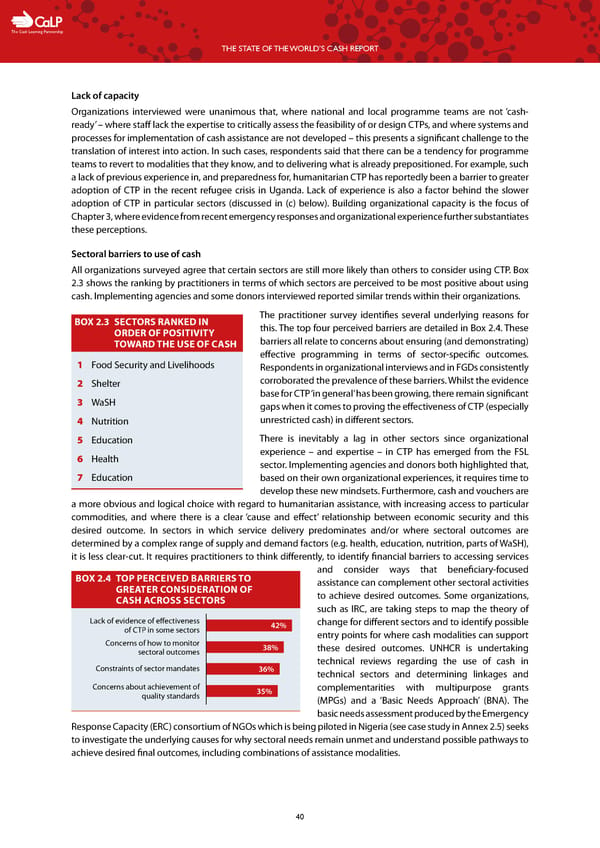C The Cash Learning Partnership THE STATE OF THE WORLD’S CASH REPORT Lack of capacity Organizations interviewed were unanimous that, where national and local programme teams are not ‘cash- ready’ – where staff lack the expertise to critically assess the feasibility of or design CTPs, and where systems and processes for implementation of cash assistance are not developed – this presents a significant challenge to the translation of interest into action. In such cases, respondents said that there can be a tendency for programme teams to revert to modalities that they know, and to delivering what is already prepositioned. For example, such a lack of previous experience in, and preparedness for, humanitarian CTP has reportedly been a barrier to greater adoption of CTP in the recent refugee crisis in Uganda. Lack of experience is also a factor behind the slower adoption of CTP in particular sectors (discussed in (c) below). Building organizational capacity is the focus of Chapter 3, where evidence from recent emergency responses and organizational experience further substantiates these perceptions. Sectoral barriers to use of cash All organizations surveyed agree that certain sectors are still more likely than others to consider using CTP. Box 2.3 shows the ranking by practitioners in terms of which sectors are perceived to be most positive about using cash. Implementing agencies and some donors interviewed reported similar trends within their organizations. BOX 2.3 SECTORS RANKED IN The practitioner survey identifies several underlying reasons for ORDER OF POSITIVITY this. The top four perceived barriers are detailed in Box 2.4. These TOWARD THE USE OF CASH barriers all relate to concerns about ensuring (and demonstrating) effective programming in terms of sector-specific outcomes. 1 Food Security and Livelihoods Respondents in organizational interviews and in FGDs consistently 2 Shelter corroborated the prevalence of these barriers. Whilst the evidence 3 WaSH base for CTP ‘in general’ has been growing, there remain significant gaps when it comes to proving the effectiveness of CTP (especially 4 Nutrition unrestricted cash) in different sectors. 5 Education There is inevitably a lag in other sectors since organizational 6 Health experience – and expertise – in CTP has emerged from the FSL sector. Implementing agencies and donors both highlighted that, 7 Education based on their own organizational experiences, it requires time to develop these new mindsets. Furthermore, cash and vouchers are a more obvious and logical choice with regard to humanitarian assistance, with increasing access to particular commodities, and where there is a clear ‘cause and effect’ relationship between economic security and this desired outcome. In sectors in which service delivery predominates and/or where sectoral outcomes are determined by a complex range of supply and demand factors (e.g. health, education, nutrition, parts of WaSH), it is less clear-cut. It requires practitioners to think differently, to identify financial barriers to accessing services BOX 2.4 TOP PERCEIVED BARRIERS TO and consider ways that beneficiary-focused GREATER CONSIDERATION OF assistance can complement other sectoral activities CASH ACROSS SECTORS to achieve desired outcomes. Some organizations, such as IRC, are taking steps to map the theory of Lack of evidence of effectiveness 42% change for different sectors and to identify possible of CTP in some sectors entry points for where cash modalities can support Concerns of how to monitor 38% these desired outcomes. UNHCR is undertaking sectoral outcomes Constraints of sector mandates technical reviews regarding the use of cash in 36% technical sectors and determining linkages and Concerns about achievement of 35% complementarities with multipurpose grants quality standards (MPGs) and a ‘Basic Needs Approach’ (BNA). The basic needs assessment produced by the Emergency Response Capacity (ERC) consortium of NGOs which is being piloted in Nigeria (see case study in Annex 2.5) seeks to investigate the underlying causes for why sectoral needs remain unmet and understand possible pathways to achieve desired final outcomes, including combinations of assistance modalities. 40
 The State of the World's Cash | Full Report Page 41 Page 43
The State of the World's Cash | Full Report Page 41 Page 43